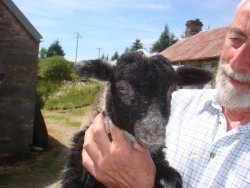Investigating the benefits of agritourism in Scotland using a typology-based approach
Published on 26 May 2011 in Sustainability and Communities

Introduction
The capacity for agritourism to generate private economic benefits for farmers has been established in a range of international contexts. However, there has been limited focus on the potential of agritourism in Scotland. In this study, a range of socio-economic benefits have been identified in association with five different types of agritourism
in five areas across Scotland. In addition, adopting a typology-based approach improved the ability to identify which types of agritourism products can generate public and private benefits, which is important in the context of multifunctional agriculture and diversification policy. A recommendation of this research is that agritourism should be included in key national policies providing for tourism and rural development.
Key Points
An empirically-based typology for defining agritourism has been developed, building on the existing agritourism literature and through analysis of provider and visitor perspectives of agritourism. The typology comprises five different categories of agritourism products, which are based on three key discriminators (Figure 1). The typology was used to explore the main drivers of supply and demand across a range of agritourism products and types available in Scotland.
Agriculture was not the primary driver in providers’ and visitors’ motivations for agritourism in this study. Instead, our study has shown that agritourism can generate a range of private benefits and fulfils both providers’ socio-economic motivations (e.g. employment, income) and general tourism-related motivations (e.g. location, scenery and value for money) associated with visitor demand. This relationship between supply-side and demand-side drivers of agritourism can be characterised as a ‘conventional tourism transaction’. This was mainly associated with three types of agritourism in this study: ‘working farm indirect interaction’ (WFII), ‘non working farm indirect interaction’ (NWFII) and ‘non working farm direct interaction’ (NWFDI) agritourism (Figure 1).

Figure 1: An empirically-based typology for defining agritourism
 However, an interesting ‘hybrid’ form of agritourism emerged, where agriculture was a supplementary driver of supply and demand. For this hybrid type, direct interaction with agriculture (in the context of ‘working farm direct staged interaction’ (WFDSI) agritourism) was found to add-value to tourism products physically located on farms but not including interaction in the visitor product (i.e. WFII agritourism). Image shown: Figure 2 - Children's play park with animal paddocks.
However, an interesting ‘hybrid’ form of agritourism emerged, where agriculture was a supplementary driver of supply and demand. For this hybrid type, direct interaction with agriculture (in the context of ‘working farm direct staged interaction’ (WFDSI) agritourism) was found to add-value to tourism products physically located on farms but not including interaction in the visitor product (i.e. WFII agritourism). Image shown: Figure 2 - Children's play park with animal paddocks.
For example, children’s play parks which also include animal paddocks (Figure 2), or accommodation with informal farm tours (Figure 3). Improved education and awareness of food and farming are key public benefits associated with this hybrid type of agritourism.
 Agriculture was a central driver of supply and demand for ‘working farm direct authentic interaction’ (WFDAI) agritourism. A compatible relationship was identified between providers, who required additional voluntary labour, and visitors, who were motivated by the opportunity to experience farm life. WFDAI agritourism is currently practiced on a relatively small scale in Scotland in terms of the size of the market (niche) and the type of agriculture (organic, specialist) involved. However there is potential for this type of agritourism to be extended to assist the implementation of agri-environmental measures on conventional farms. In this context, WFDAI agritourism can be associated with other forms of volunteer tourism. Image shown: Figure 3 - Accommodation with informal farm tours.
Agriculture was a central driver of supply and demand for ‘working farm direct authentic interaction’ (WFDAI) agritourism. A compatible relationship was identified between providers, who required additional voluntary labour, and visitors, who were motivated by the opportunity to experience farm life. WFDAI agritourism is currently practiced on a relatively small scale in Scotland in terms of the size of the market (niche) and the type of agriculture (organic, specialist) involved. However there is potential for this type of agritourism to be extended to assist the implementation of agri-environmental measures on conventional farms. In this context, WFDAI agritourism can be associated with other forms of volunteer tourism. Image shown: Figure 3 - Accommodation with informal farm tours.
Research Undertaken
Interviews and questionnaires were conducted in twenty-five agritourism locations across Scotland, including provider and visitor perspectives. Overall, primary data was collected from twenty-five provider interviews, twenty-two visitor interviews, and 349 visitor questionnaires. Data collection was structured using an initial version of the agritourism typology (Phillip et al., 2010). The ‘typology-based approach’ that underpinned this study can also act as a foundation for agritourism research in other countries and contexts.
Policy Implications
The economic potential of agritourism is not currently reflected in Scotland’s national tourism (Scottish Tourism:
The Next Decade, 2006) or rural development (Scotland Rural Development Programme 2007–2015) policies. Agritourism should be included in these national policies, to help establish the concept of agritourism in Scotland, and to recognise the potential of agritourism’s contribution to the rural economy. Furthermore, different types and combinations of agritourism have the potential to simultaneously generate private (income, employment, capital) and public (e.g. education, agri-environment) benefits. Agritourism also has an important role in facilitating the transition towards more diverse and multifunctional rural areas in Scotland.
Author
Flanigan, S., Blackstock, K. and Hunter C. sharon.flanigan@hutton.ac.uk
Topics
Sustainability and Communities







